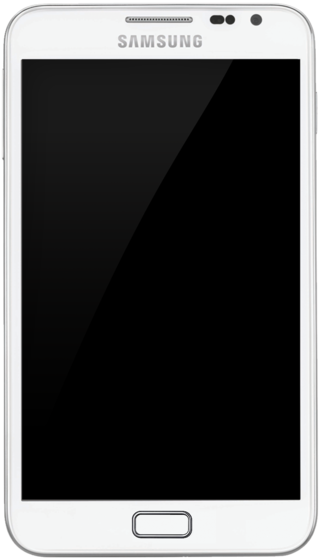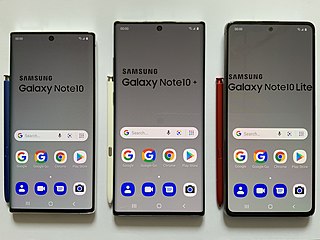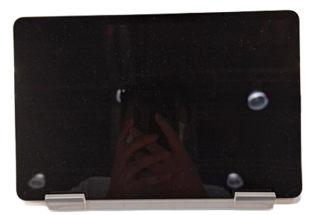
A smartphone is a portable computer device that combines mobile telephone functions and computing functions into one unit. They are distinguished from older-design feature phones by their more advanced hardware capabilities and extensive mobile operating systems, which facilitate wider software, access to the internet, and multimedia functionality, alongside core phone functions such as voice calls and text messaging. Smartphones typically contain a number of metal–oxide–semiconductor (MOS) integrated circuit (IC) chips, include various sensors that can be leveraged by pre-installed and third-party software, and support wireless communication protocols. More recently, smartphone manufacturers have begun to integrate satellite messaging connectivity and satellite emergency services into devices for use in remote regions where there is no reliable cellular network.

The Samsung SCH-U750, marketed as Samsung Alias 2 and also as Samsung Zeal, was a cell phone made by Samsung. The phone was only available in metallic gray. It features a dual-hinge design that can be opened in portrait or landscape style. The Alias 2 featured an E Ink-based keyboard. In horizontal mode it features a QWERTY keyboard and VCAST music on the Verizon Wireless network within Australia and the USA.

Livestation was a platform for distributing live television and radio broadcasts over a data network. It was originally developed by Skinkers Ltd. and is now an independent company called Livestation Ltd. The service was originally based on peer-to-peer technology acquired from Microsoft Research. Between mid-June 2013 and mid-July Livestation was unavailable to some subscribers due to technical issues.
The Omnia series is a line of smartphones produced by Samsung Electronics. Omnia devices run either Microsoft's Windows Mobile 6.5, or Windows Phone 7 operating systems, and one Symbian device under the brand was also released.

The Samsung Focus is a slate smartphone which runs Microsoft's Windows Phone operating system. It features a 1 GHz Qualcomm® Snapdragon™ processor, a 4.0-inch Super AMOLED screen, and 8GB of internal storage. As of November 2011, it is the 4th lightest and thinnest Windows Phone, behind the Samsung Focus Flash, HTC Titan and the Samsung Focus S, a more high-end version of the original Focus.

The Samsung Infuse 4G was an Android smartphone that was released by Samsung in May 2011. It has a 1.2 GHz Hummingbird processor with 8–16 GB internal Flash memory, a 4.5 inch 480×800 pixel Super AMOLED Plus capacitive touchscreen display, an 8-megapixel camera and a 1.3-megapixel front-facing camera.

The Samsung Galaxy Note is an Android smartphone produced by Samsung Electronics. Unveiled at IFA Berlin 2011, it was first released in Germany in late October 2011, with other countries following afterwards. The Galaxy Note was distinguished by its unusually large form factor—later referred to using the term "phablet"—which straddled the size of the average smartphone at the time, and that of a small tablet: it features a 5.3-inch display, and is bundled with a stylus branded as the "S Pen", which can be used to navigate the device's user interface, and write or draw in supported apps.

Lenovo smartphones are marketed as the "LePhone" in Mainland China and the "IdeaPhone" overseas. Motorola Mobility, ZUK Mobile and Medion, divisions of Lenovo, sell smartphones under their own brands. On April 27, 2017, Lenovo announced that the ZUK brand would cease operations. As of September 2015, Lenovo is in the process of rebranding most of its phones using the Motorola brand name.

The Samsung ATIV S was a touchscreen, slate smartphone manufactured by Samsung Electronics running the Windows Phone 8 operating system, upgradeable to Windows Phone 8.1. The ATIV S was Samsung's first Windows Phone 8 device, and one of the first devices under its ATIV series of Microsoft Windows-based products. It was shown at the IFA 2012 in Berlin and was the first Windows Phone 8 device to be officially unveiled, ahead of the Nokia Lumia 920.

The Samsung Galaxy Note series is a discontinued line of high-end Android phablets and smartphones developed and marketed by Samsung Electronics. The line is primarily oriented towards pen computing; all Galaxy Note models ship with a stylus pen and incorporate a pressure-sensitive Wacom digitizer. All Galaxy Note models also include software features that are oriented towards the stylus and the devices' large screens, such as note-taking, digital scrapbooking apps, tooltips, and split-screen multitasking. The line served as Samsung's flagship smartphone model, positioned above the Galaxy S series.

The Samsung Galaxy Note 4 is an Android smartphone developed and produced by Samsung Electronics. It was unveiled during a Samsung press conference at IFA Berlin on 3 September 2014 and was released globally in October 2014 as successor to the Samsung Galaxy Note 3. Improvements include expanded stylus-related functionality, an optically stabilized rear camera, 1440p quad-HD filming on the front camera, significantly increased charging rate, revised multi-windowing, and fingerprint unlocking. It is the last in the Samsung Galaxy Note series with interchangeable battery. Its subsequent model, the Samsung Galaxy Note 5, was unveiled on 13 August 2015.

The Samsung Galaxy S5 is an Android-based smartphone unveiled, produced, released and marketed by Samsung Electronics as part of the Samsung Galaxy S series. Unveiled on 24 February 2014 at Mobile World Congress in Barcelona, Spain, it was released on 11 April 2014 in 150 countries as the immediate successor to the Galaxy S4. As with the S4, the S5 is an evolution of the prior year's model, placing a particular emphasis on an improved build with a textured rear cover and IP67 certification for dust and water resistance, a more refined user experience, new security features such as a fingerprint reader and private mode, expanded health-related features including a built-in heart rate monitor, a USB 3.0 port, and an updated camera featuring speedy auto-focus through phase-detection The video resolution has been upgraded to 2160p (4K) and the frame rate at 1080p has been doubled to 60 for a smooth appearance.

The HTC One (M8) is an Android or Windows smartphone manufactured and marketed by HTC. Following a number of leaks that occurred during the months prior, the device was officially unveiled in a press conference on March 25, 2014, and released the same day by Verizon Wireless at retail, and by other Canadian and United States carriers for online orders prior to its wider retail availability in mid-April.

The Samsung Galaxy S6 is a line of Android-based smartphones manufactured, released and marketed by Samsung Electronics. Succeeding the Samsung Galaxy S5, the S6 was not released as a singular model, but instead in two variations unveiled and marketed together—the Galaxy S6 and Galaxy S6 Edge—with the latter differentiated primarily by having a display that is wrapped along the sides of the device. The S6 and S6 Edge were unveiled on March 1, 2015, during the Samsung Unpacked press event at MWC Barcelona, and released April 10, 2015, marking a counter-utilitarian and fashion-oriented course in the Galaxy S series. During the subsequent Samsung Unpacked event on August 13, 2015, Samsung unveiled a third model, the Galaxy S6 Edge+, which features a larger phablet-sized display and more memory, but lacks an infrared transmitter used for remote controlling.

The Samsung Galaxy S7, Samsung Galaxy S7 Edge and Samsung Galaxy S7 Active are Android-based smartphones manufactured, released and marketed by Samsung Electronics. The S7 series serves as the successor to the Galaxy S6, S6 Edge, S6 Edge+ and S6 Active released in 2015. The S7 and S7 Edge were officially unveiled on 21 February 2016 during a Samsung press conference at Mobile World Congress, with a European and North American release on 11 March 2016. The S7 Active was unveiled on 4 June 2016, and released on AT&T in the United States on 10 June 2016.
The Samsung Omnia M is a budget smartphone developed by Samsung. Part of the Omnia series, it was announced in May 2012 and released in July 2012 in the European market. The phone also became available in China on China Mobile and China Unicom, as well as in Brazil. A version was planned for China Telecom but was never released.

The Samsung Galaxy Note 8 is an Android-based smartphone phablet designed, developed, produced and marketed by Samsung Electronics. The successor to the discontinued Samsung Galaxy Note 7, Samsung Galaxy Note Fan Edition and Samsung Galaxy Note 5, it was unveiled on 23 August 2017 and became available on 15 September 2017.

The Samsung Galaxy Note 10 is a line of Android-based phablets designed, developed, produced, and marketed by Samsung Electronics as part of the Samsung Galaxy Note series. They were unveiled on 7 August 2019, as the successors to the Samsung Galaxy Note 9. Details about the phablets were widely leaked in the months leading up to the phablets' announcement.

The Samsung Galaxy Z Fold 2 is an Android-based foldable smartphone developed by Samsung Electronics for its Samsung Galaxy Z series, succeeding the Samsung Galaxy Fold. It was announced on 5 August 2020 alongside the Samsung Galaxy Note 20, the Samsung Galaxy Tab S7, the Galaxy Buds Live, and the Galaxy Watch 3. Samsung later revealed pricing and availability details on 1 September.

The Samsung Galaxy Tab S8 is a series of Android-based tablets designed, developed and marketed by Samsung Electronics. Unveiled at Samsung's Galaxy Unpacked event on 9 February 2022, they serve as the successor to the Galaxy Tab S7 series.


















